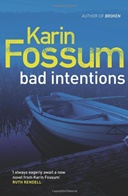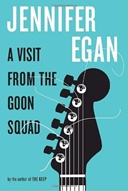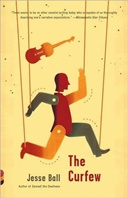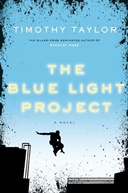“Her new book was on the phenomenon of word casings, a term she’d invented for words that no longer had meaning outside quotation marks. English was full of these empty words – ‘Friend’ and ‘real’ and ‘story’ and ‘change’ – words that had been shucked of their meanings and reduced to husks. Some like ‘identity’, ‘search’, and ‘cloud’ had clearly been drained of life by their Web usage. With others, the reasons were more complex; how had ‘American’ become an ironic term? How had ‘democracy’ come to be used in an arch mocking way?”
— Jennifer Egan, A Visit from the Goon Squad
 |
The Man Who Smiled Henning Mankell A friend gave me this Swedish crime novel, knowing how much I loved Stieg Larsson’s Millenium Trilogy.* Looking up author Henning Mankell on Wikipedia, I learn that he is a well-known crime writer whose most famous character is Kurt Wallander, a police inspector from the southern coastal city of Ystad. The Man Who Smiled is a fine crime novel, but one most American readers will find a little sedate. Kurt Wallandar has taken a year off to deal with the shock and psychological trauma of having shot and killed a man in self-defense at the end of the previous novel (imagine a fictional American police inspector being even the least bit bothered by the shooting of a bad buy in self-defense!). A friend seeks Kurt out to ask his help in investigating the suspicious death of the friend’s father, and two weeks later the friend is murdered. Kurt, who had been on the verge of retiring on a mental disability pension, decides to return to his post and head up the investigation into his friend’s murder. Over the course of the novel, Kurt and a policewoman sidekick solve a series of interconnected murders and financial crimes. It’s well done but not at all like Stieg Larsson’s Millenium novels. The crime to be solved is an interesting one, but there’s little passion on the part of the characters. Kurt is feeling his way back into a state of normalcy in the wake of the shooting, which occurred a year or more in the past, and suffers from self-doubt. He works on the crime, not just with the new female sidekick, but a large cast of other policemen and prosecutors, and comes across as an effective bureaucrat, not an action hero. The investigation goes forward in small increments, inching toward a conclusion. There is no sex. There is no drinking (apart from the drinking of a minor character, and Kurt actually takes the man’s keys away to keep him from driving drunk … how charmingly Swedish!). There isn’t even any shooting until the climactic scene at the end. In other words, it’s all rather old-fashioned. And that’s a nice change. * My reviews of the Steig Larsson books are here: |
 |
Bad Intentions Karin Fossum I’m not sure whether a friend told me about this book or if I saw it mentioned on a website; either way, it was presented to me as a Scandinavian crime novel in the mold of Steig Larsson’s Millenium Trilogy (there’s that Larsson guy again!). Everyone is recommending Scandinavian crime novels these days, riding on Larsson’s coattails. Well. Bad Intentions is nothing at all like Larsson. There’s not a hint of Lisbeth Salander here, or even Mikael Blomkvist. The author isn’t even Swedish; she’s Norwegian. Bad Intentions is one of Fossum’s “Inspector Sejer” series, and Fossum is known (according to Wikipedia) as “Norway’s Queen of Crime.” Interestingly enough, Bad Intentions is not a police procedural, though you’d expect it to be. Inspector Sejer is a background character here, making a few appearances but not really involved in solving the crime. The three young men who were the perpetrators of the crime undo themselves and one of them eventually confesses. And the crime? It’s not much of anything at all — neglectful manslaughter at most, the sort of thing that wouldn’t even be prosecuted in the United States. As crime novels go, this one is a “meh.” Look, peeps, stop recommending books just because they come from Sweden or Norway. Second-rate crime novels are all about the same, no matter what language they were originally written in. Being Scandinavian does not a Steig Larsson make. |
 |
A Visit from the Goon Squad Jennifer Egan I gather this novel won a Pulitzer for fiction. I can see why. Each chapter could stand on its own as a short story, but the novel pulls the stories together into a coherent, powerful narrative. The characters are all involved in the music industry, spanning a period of time dating from the punk rock era into the near future, 2020 or so. The story’s not told from one point of view, or chronologically, but it adds up in a very satisfactory, refreshing manner. I read several reviews before reading the novel itself. Perhaps the most remarked upon chapter is told by a teenaged girl in the form of a Powerpoint presentation, but really, to me every chapter was brilliant. The book’s message, that we get older and change (and in most cases sell out in order to survive), is not especially revelatory, but it’s told in such an engaging way as to seem new and insightful. This was a thoroughly entertaining read. |
 |
The Curfew Jesse Ball Minimalist, poetic, Kafkaesque, somewhat pretentious. A short novel, not really even a novella, but it its brevity one that tells a large story. Jesse Ball gives you the outline, images, ideas, and tools from which you flesh out the story with your own experiences and reading, a pretty neat trick. Two elements of The Curfew made a strong impression on me: William’s secondary occupation as epitaphorist (which he took up after society became a police state and the curfew was imposed — he had been a concert violinist before music was banned), a man who helps the bereaved compose epitaphs for tombstones; the informal resistance movement’s “idea” or “concept,” which boils down to killing agents of the police state whenever and wherever possible. The magical puppet show of the second half of the book was too arty and Pan’s Labyrinth-ish for me. I will say, though, that the book got under my skin. I won’t forget it. |
 |
Remainder Tom McCarthy A man suffers head injuries after being struck by an unspecified object falling from the sky. After emerging from a coma he endures months of physiotherapy, learning to speak and control his body by rerouting commands through undamaged parts of his brain. He returns to his previous life but feels disconnected. A massive financial settlement comes through; he is suddenly wealthy enough to do whatever he wants. In a bathroom at a friend’s party, he zones out and experiences an extended déjà vu-like vision of a flat in an apartment building. While other party-goers pound on the bathroom door, he mentally explores the flat in the vision, feeling connected and normal once again. After the party he sets out to create the reality he has glimpsed, right down to converting a building to duplicate the one he imagined and hiring people to play the neighbors. One elaborate and expensive re-enactment leads to another, then another, as he plays god with other peoples’ lives … ultimately to disastrous effect. The character is repellant, unlikable, fascinating. Reading McCarthy’s novel, I thought of Sartre and Philip K. Dick. If Remainder is anything, it is existential. This is a first novel, and according to what I’ve picked up online, a word-of-mouth hit … just like The Girl with the Dragon Tattoo was a few years ago. Tom McCarthy is a name to remember. |
 |
The Blue Light Project Timothy Taylor Terrific right up to the end, and still pretty good then. There’s a fantastical, science-fiction aspect to the story, in that the events unfold in the near future in a fictional but lovingly detailed Midwestern city … almost a parallel universe. The main characters are quite real, though, and they keep you grounded. Eve Latour is a former Olympic biathlete, universally recognized and beloved in her hometown, searching for her missing brother, a former street artist and junkie. Thom Pegg is a washed-up journalist and alky, here at the request of a terrorist who has taken a theater and part of its audience hostage. Mov, the terrorist, is a former government contractor who once tortured detainees at black sites around the world. Rabbit is a second-generation street artist with a grand plan, the Blue Light Project. As Mov holds his theater audience as well as the entire city hostage, the characters are drawn together, each working out his or her own problems, and the mysterious Blue Light Project becomes as suspenseful and gripping as the ongoing hostage situation in the city center. The characters are not foils; they learn from one another and grow, and you wind up rather caring about them. Each of them is looking for something, and each of them, in the end, find what they’re looking for. All this unfolds against grand themes of contemporary society: celebrity, authority, black operations, terrorism, the use of technology to gather data and spy on people, the phenomenon of street art, the co-option of same for commercial purposes, social unrest and mob actions — all very real and urgent. My only dissatisfaction was with the ending, the long-promised revelation of the Blue Light Project itself, which could not have had the effect the author describes. It’s a rooftop art installation, really visible only to two characters who happen to be perched atop a disused radio tower on a ridgeline overlooking the city. In the story it somehow calms the mobs rioting down in the streets between skyscrapers, where it would have been invisible. This bit of mechanical impossibility, like an implausible detail in a science fiction story, undermined all the rest. What might have been a brilliant story became, at the end, merely terrific. Timothy Taylor’s novel strongly reminded me of Stuart Archer Cohen’s The Army of the Republic, which I loved (and reviewed here). This was a great read, and I’ll keep my eye out for more by Timothy Taylor. |